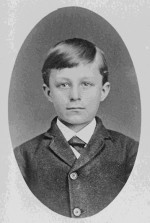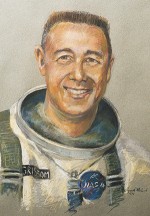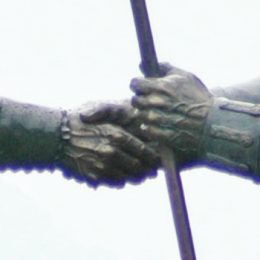
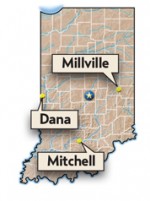 In April, Indiana marks the birthdays of two legendary aviation pioneers — one you may not even realize was born a Hoosier — and commemorates the anniversary of the loss of a beloved Hoosier journalist.
In April, Indiana marks the birthdays of two legendary aviation pioneers — one you may not even realize was born a Hoosier — and commemorates the anniversary of the loss of a beloved Hoosier journalist.
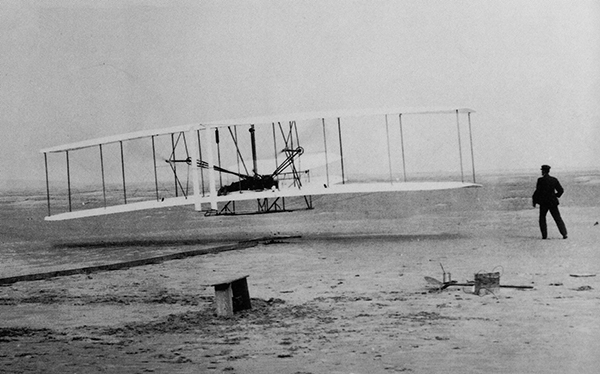
Wilbur Wright, who was born in Indiana, pilots the first flight of the flyer he and brother Orville, right, at Kitty Hawk, North Carolina in 1903.
Aviation pioneers Wilbur and Orville Wright, brothers who developed the world’s first successful airplane, are rightly associated with our neighboring state of Ohio. But many might be surprised to learn the eldest, Wilbur, was born in a small farm house near Millville, Indiana, April 16, 1867.
He was the third child of the Rev. Milton Wright and Susan Catherine Koerner Wright. In the spring of 1869, the family moved to Dayton, Ohio, where Orville was born in 1871.
In June 1881, the family moved to Richmond, Indiana, where Wilbur completed the requirements to graduate. But the family returned to Dayton in June 1884 before Wilbur could receive his diploma. (Richmond High School awarded Wilbur his diploma posthumously — on the 127th anniversary of his birth in 1994.)
As adults back in Dayton, Wilbur and Orville opened a bicycle shop in 1892 and pursued their growing interest in powered flight. By 1901, they began putting their theories to the test on the Atlantic shoreline at Kitty Hawk, North Carolina. On Dec. 17, 1903, they made the first free, controlled flight of a power-driven airplane. Wilbur piloted their flyer for 59 seconds over a distance of 852 feet, and the brothers achieved worldwide acclaim.
In April 1912, Wilbur contracted typhoid on a trip to New York and died May 30, 1912, in Dayton. He was 45 years old.
Today, the home in Millville is operated as the Wilbur Wright Birthplace. Its museum includes a full-size replica of their first plane. The site opens for the season April 1. For more information about the museum, call: 765-332-2495; or visit: www.wwbirthplace.com.
When the United States selected its first group of astronauts in 1959, among the original seven with the “right stuff” was Hoosier Virgil “Gus” Grissom.
Born April 3, 1926, Grissom grew up in Mitchell. After high school graduation in 1944, he enlisted as an aviation cadet in the U.S. military, briefly served, then earned a degree from Purdue University. He rejoined the military and flew combat missions during the Korean War and became a test pilot and an instructor.
On April 13, 1959, Grissom was chosen as one of the Project Mercury astronauts. On July 21, 1961, he became the second American in space. He also flew NASA’s first manned Gemini mission with John Young on March 23, 1965. Grissom designed so much of the Gemini capsule, other astronauts called it “the Gus mobile.”
Grissom was selected to command the first manned Apollo mission as well. But on Jan. 27, 1967, Grissom and his crew, Ed White and Roger Chaffee, died during testing on the launch pad when a fire broke out in the command module and consumed their spacecraft in seconds. He was 40 years old.
Long before 24/7 cable news “embedded” journalists with U.S. military units during the Iraq war of 2003, one of the world’s most beloved war correspondents slogged alongside the boys on the battlefields of Europe and the islands of the Pacific in World War II.
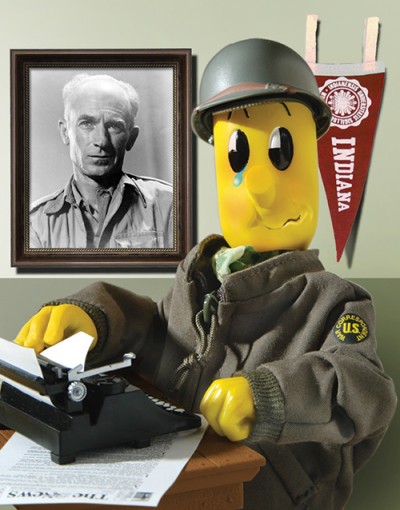
Willie Wiredhand says the average G.I. Joe and Americans back home lost a good buddy when World War II correspondent Ernie Pyle died.
Native Hoosier Ernie Pyle wrote stories home about the average G.I. Joe’s daily struggles of life and death. Pyle, himself, paid the ultimate price — dying with those soldiers on a remote Pacific island, April 18, 1945.
Pyle was born Aug. 3, 1900, near Dana. After serving in the Navy at the end of World War I, Pyle studied journalism at Indiana University. Just short of graduating, he took a newspaper job in LaPorte. He later became a roving national columnist, earning acclaim for his accounts of ordinary people in rural America. When WW II started, he lent the same distinctive, folksy style to his war-time reports. Pyle got in the foxholes and wrote from the perspective of the common soldier.
After spending most of the war in Europe, Pyle moved to the Pacific in early 1945. On April 17 that year, during the Battle of Okinawa, he joined an infantry regiment on the small island of Iejima (then known as Ie Shima). The next day, a Japanese machine gun fired on the jeep in which he was riding. Pyle and others hit the dirt. But when Pyle raised his head to check on the others, a bullet hit him in the head below his helmet. He died instantly. He was 44.
Today, the restored home where Pyle was born in Dana is operated as the Ernie Pyle World War II Museum. It is open to the public May 1 through Veterans Day. For more information, contact the museum at 765-665-3633; or http://www.erniepyle.org.
Stay tuned each month as Willie presents more Indiana “Bicentennial Zingers.”

